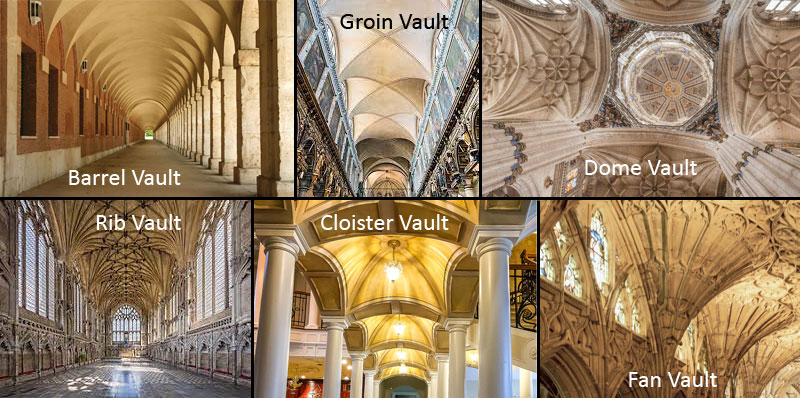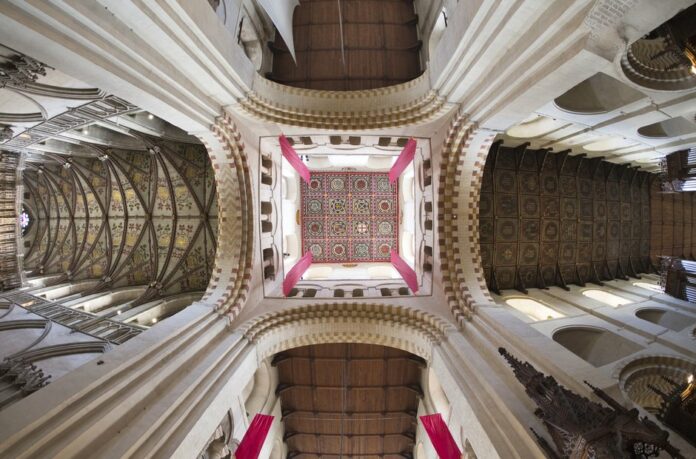A vaulted ceiling is a type of ceiling that angles up toward the roof to extend higher than the standard eight- to ten-foot height of average flat ceilings. It is characterised by its upward-sloping sides that meet at a peak, resembling the shape of an inverted V or a curved arch. Unlike a traditional flat ceiling, a vaulted ceiling has a higher point or apex in the centre and slopes down towards the walls or sides of the room. The shape of a vaulted ceiling can vary, ranging from gentle curves to more dramatic arches. Vaulted ceilings are often associated with grand architectural designs, such as cathedrals, churches, or historic buildings. However, they have also become popular in residential homes and modern commercial spaces as a way to add visual interest, create a sense of spaciousness, and enhance the overall aesthetics of the interior.
Vaulted ceiling materials
Vaulted ceilings can be constructed using a variety of materials, each with its own aesthetic, structural, and practical characteristics. Here are some commonly used materials for vaulted ceilings:
1. Wood: Wood is a popular choice for vaulted ceilings due to its natural warmth. Various types of wood, such as oak, pine, cedar, or beech, can be used to create exposed beams, tongue-and-groove paneling, or timber framing for the vaulted ceiling.
2. Plaster: Plaster is a traditional material used for vaulted ceilings, particularly in classical and historical architectural styles. It can be applied in layers over a supporting framework, creating a smooth and elegant surface. Plaster ceilings can be left plain or embellished with decorative mouldings, reliefs, or ornamental details.
3. Concrete: Concrete is a durable and versatile material suitable for constructing vaulted ceilings. It can be poured into formwork or cast in precast panels, allowing for various shapes and designs.
4. Metal: Metal materials, such as steel or aluminium, can be used to create vaulted ceilings in contemporary or industrial-style designs. Metal vaults are lightweight, provide structural strength, and offer opportunities for unique shapes and patterns.
5. Stone: Stone vaulted ceilings add a sense of grandeur and a timeless appeal to a space. Natural stone, such as limestone, marble, or granite, can be cut and shaped to form the vaulted structure. Stone vaulted ceilings are commonly found in historic buildings, churches, or high-end architectural projects.
6. Glass: Glass can be used to create stunning vaulted ceilings that allow abundant natural light to flood the space. Glass panels or skylights can be incorporated into the vaulted structure, providing transparency and a modern aesthetic. Glass vaulted ceilings are often seen in contemporary architecture or conservatories.
7. Composite Materials: Composite materials, such as fibreglass-reinforced panels (FRP) or engineered wood products, offer a lightweight and cost-effective option for vaulted ceilings. These materials can mimic the appearance of wood, stone, or other finishes while providing durability and ease of installation.
Vaulted ceiling advantages
Vaulted ceilings offer several advantages that contribute to the overall appeal and functionality of a space. Here are some advantages of vaulted ceilings:
Improved Natural Light and Ventilation: The increased height of vaulted ceilings allows for larger windows or skylights, maximizing the entry of natural light into the room. This creates a brighter and more inviting environment. Additionally, the extra height can enhance natural ventilation, promoting better air circulation and comfort.
Acoustic Benefits: Vaulted ceilings can contribute to better acoustics in a room. The angled surfaces and higher ceiling can help reduce echoes and improve sound distribution, resulting in better sound quality and a more pleasant auditory experience.
Design Flexibility: Vaulted ceilings offer design flexibility, allowing for various creative possibilities. They can accommodate unique architectural features like exposed beams, intricate moldings, or artistic ceiling treatments. Additionally, vaulted ceilings can be combined with different materials, finishes, and lighting techniques to achieve a desired aesthetic style.
Better Acoustics: The shape and volume of a vaulted ceiling can contribute to improved acoustics within a room. The curved or arched surface helps to disperse and diffuse sound waves, reducing echoes and reverberations. This can enhance the quality of sound in spaces like auditoriums, concert halls, or even living areas.
Enhanced Ventilation: Vaulted ceilings provide an opportunity for improved airflow and ventilation. The increased ceiling height allows hot air to rise and circulate more effectively, promoting natural ventilation and reducing the need for mechanical cooling. This can contribute to a more comfortable and energy-efficient environment.
Energy Efficiency: In spaces with vaulted ceilings, the additional height provides extra space for hot air to rise and circulate. This natural convection can help with temperature regulation, especially in warmer climates, potentially reducing the need for excessive cooling. Additionally, the increased natural light can reduce the reliance on artificial lighting during the day, leading to energy savings.
Enhanced Aesthetics: Vaulted ceilings add architectural interest and visual appeal to a space. They create a sense of grandeur and elegance, giving a room a more luxurious and upscale feel. Vaulted ceilings can serve as a focal point and elevate the overall design and ambiance of a space.
Types of vaulted ceiling
There are various types of vaulted ceilings, each with its own distinct design and characteristics. Here are some different types:
Barrel Vault: A simple, continuous, and arched ceiling that resembles the shape of a rounded barrel or tunnel. It is formed by a series of arches or a single arched structure and is often used to cover long, rectangular spaces.
Groin Vault: Also known as a cross vault or a double barrel vault, is formed by the intersection of two barrel vaults at right angles. It creates a more complex and decorative pattern with the crossing of arches.
Rib Vault: Consists of a series of arched ribs that create a skeletal framework, supporting the ceiling. The ribs can intersect to form intricate patterns and add aesthetic appeal to the vaulted ceiling. Rib vaults are commonly seen in Gothic architecture.
Dome Vault: Rounded or hemispherical ceiling that covers a circular or polygonal space. It can be a half-dome or a full dome, and it often creates a sense of grandeur and spaciousness. Dome vaults are commonly found in religious buildings and large public structures.
Cloister Vault: The vault is created by intersecting barrel vaults, resulting in a series of rectangular or square bays. It is commonly used in covered walkways or cloisters of monastic buildings.
Fan Vault: Decorative vaulting type where intricately carved stone ribs radiate from a central point, resembling a fan. It is commonly found in late Gothic architecture and adds an ornate and elegant touch to the ceiling.
Lierne Vault: Characterised by the addition of extra decorative ribs called liernes, which connect between the main ribs of a vaulted ceiling. This creates a more intricate and detailed pattern.
Inverted Vault: Also known as a saucer dome or a reverse vault, has an upward-curving shape that is concave instead of the typical convex shape. It creates a unique and eye-catching design element.
Pitched Brick Vault: Constructed using bricks arranged in a pitched or sloping manner. The construction of a pitched brick vaulted ceiling involves creating a series of arched or curved brick layers that gradually slope upward, resembling the shape of a barrel. The bricks are laid in a specific pattern, such as a herringbone or basket weave, to ensure stability and structural integrity. They can be seen in structures such as churches, cathedrals, old houses, or public buildings.

Vaulted ceiling applications
Vaulted ceilings find applications in various architectural and interior design contexts. Here are some common applications of vaulted ceilings:
1. Residential Homes: Vaulted ceilings are frequently used in residential homes, particularly in living rooms, master bedrooms, entryways, or dining areas. They add a touch of grandeur and create an open and spacious feel, enhancing the overall design and ambiance of the living space.
2. Religious Buildings: Vaulted ceilings have a long-standing tradition in religious architecture. They are prevalent in churches, cathedrals, mosques, and temples, where they symbolize the heavenly realm, create a sense of awe, and contribute to the spiritual experience.
3. Public Buildings: Many public buildings, such as government structures, museums, libraries, or concert halls, incorporate vaulted ceilings. The vaulted design adds a sense of grandeur and architectural significance to these public spaces, creating an impressive and memorable environment.
4. Commercial Spaces: Vaulted ceilings can be found in commercial spaces like hotels, restaurants, shopping malls, or office buildings. They are used to make a strong visual impact, create an upscale atmosphere, and provide a unique architectural feature that sets the space apart.
5. Historical and Heritage Buildings: Vaulted ceilings are prevalent in historical and heritage buildings, including castles, palaces, and old mansions. These ceilings often represent the craftsmanship and architectural style of a specific era, preserving the building’s historical value and contributing to its cultural significance.
6.Outdoor Spaces: Vaulted ceilings can also be used in outdoor spaces such as covered patios, verandas, or pergolas. They provide shade, architectural interest, and a sense of outdoor grandeur, creating an inviting and comfortable space for relaxation or entertainment.
7. Residential Renovations: Vaulted ceilings can be introduced during renovation projects to transform existing spaces. By removing a flat ceiling and replacing it with a vaulted design, homeowners can create a more open and visually appealing living area.

Conclusion
Discussed above are different materials used, advantages, types and applications of vaulted ceiling.


